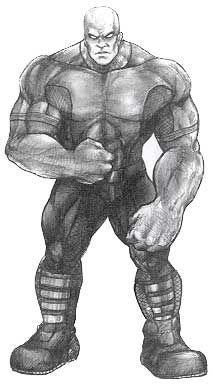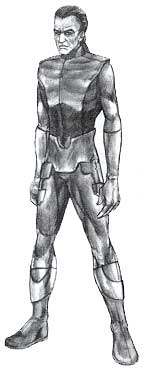Most people use the term "Human" to refer to the species itself, or one of its members. They reserve the term "Terran"mostly for things or institutions associated with Humanity - the Terran Empire, Terran technology, Terran military tactics, the Terran influence on galactic politics. Some people use "Human" for such things, though.

The Human species, known also as Terrans or Earthlings, comes from the planet Earth. As the founders of and dominant species in the erran Empire, they're one of the most powerful species in the Galaxy.
Humans have a fairly common body structure - bipedal, upright posture, two manipulating hands, a head containing the brain and sense organs, and an internal skeleton. In fact, scientists throughout the Galaxy widely use the term "humanoid" to refer to the general body shape of many species.
In Galactic society, Terrans are known for blindingly rapid technological and social change and their ability to adapt to an enormous number of environments and situations. However, many aliens also regard them as capricious, powermongering, and violent. Many species hope the Terran Empire's relatively long period of dominance indicates Humans have finally "settled down" to a more stable social pattern.
Ordinary Humans do not have a Package Deal. They are the default from which other Package Deals derive.
Most Humans come from unmodified Earth stock, but a few groups have altered the genes of their children to create variant subspecies. Four of those variant types have become successful enough to number in the millions or billions during the Imperial era.
Variant Humans are still Human. They can have children with different variant types or unmodified Humans, although with a greater chance of miscarriage or birth defect than normal (and many only find "their own kind" sexually appealing). Abilities tend to "average out" in halfbreeds - the child of a Martian and an unmodified Terran would probably have greater strength than most Martians, but less ability to withstand low air pressure or function in low gravity.

| Heavy Package Deal | |
|---|---|
| Ability | Cost |
| +5 STR | 5 |
| +4 Con | 8 |
| +3 BODY | 6 |
| Heavy: Knockback Resistance -1" | |
| High Gravity Training: Environmental Movement (High-G) | 1 |
| Used to High-G: Armour (2PD/0ED); Only to protect against G-force damage (-1) | 1 |
| Disadvantages | Value |
| -1 DEX | -3 |
| Physical Limitation: Large (infrequently, slightly impairing) | -5 |
| Total Cost of Package: | 15 |
Adapted for life on high-gravity worlds, Heavies (or "Heavyworlders") are thick-set, muscular Humans with strong bones, high-pressure circulatory systems, and lungs able to handle dense atmospheres. Tougher and stronger than normal Humans, they make good soldiers, barroom brawlers, miners, engineers, and heavy laborers. In normal Human society, they often have difficulty fitting through doors, using equipment designed for standard-size Human hands, and so forth (the GM may impose Skill Roll penalties for the use of some tools, if appropriate). The Empire has about 5 billion Heavies on a dozen planets.

| Martian Package Deal | |
|---|---|
| Ability | Cost |
| Adapted to the Martian Environment: Life Support (Expanded breathing: can breathe normally in thin atmospheres) | 1 |
| Low Gravity Training: Enviromental Movement (Low-G) | 4 |
| Disadvantages | Value |
| -2 STR | -2 |
| -1 CON | -2 |
| -1 BODY | -2 |
| Total Cost of Package: | -1 |
Though originally created to live without protection on quasi-terraformed Mars, Martians now live on many other Type 3 worlds. Tall and barrel-chested, they have increased resistance to ultraviolet radiation and lungs that function at low atmospheric pressure. But they also have bodies and bones weaker than those of Humans from Earth-normal environments, making them somewhat "fragile". Approximately 10 billion Martians live in the Empire on various worlds; the largest single population is on Mars itself. The designation "Martian" should not be confused with "Native Martian", the term xenologists use when discussing life-forms that evolved naturally on Mars.

| Selkie Package Deal | |
|---|---|
| Ability | Cost |
| Water-Breathing: Life Support (Extended breathing � 1 END per minute; Safe environments: high pressure, cold) | 5 |
| Webbed hands and feet: Swimming +3� | 3 |
| Nightvision | 5 |
| Environmental Movement: aquatic movement | 3 |
| Disadvantages | Value |
| Physical Limitation: Light-sensitive eyes (-2 sight PER in bright light; frequently, slightly impairing) | -10 |
| Vulnerability: 2 x effect from Sight Group Flashes based on bright light (common) | -20 |
| Total Cost of Package: | -14 |
Selkies (also known as Merfolk, Sea People, and Tritons) live on many water worlds in the Empire (not to mention the oceans of Earth). They can't literally breathe water (attempts to create Humans with true gills have met with only limited success), but their enhanced lung capacity allows them to stay underwater as long as seals. Their large, rounder-than-normal eyes help them to see without difficulty when they're deep underwater, but are also sensitive to bright light (such as direct sunlight). An insulating fat layer helps them withstand the effects of living in frigid waters, and their webbed hands and feet allow them to move through those waters with ease. The Empire has some 6 billion Selkies among its population.
| Spacer Package Deal | |
|---|---|
| Ability | Cost |
| Spaceborn: Life Support (Extended Breathing: can breath normally in thin atmospheres; Safe Environment: low-intensity radiation) | 2 |
| Feet as useful as hands: Extra Limbs (2) Inherent (+1/4) | 6 |
| Zero-G Training: Environmental Movement (Zero-G) | 4 |
| Disadvantages | Value |
| -2 STR | -2 |
| -1 CON | -2 |
| Physical Limitation: has difficulty in normal gravity (-2 to all DEX and STR rolls; frequently, slightly impairing) | -10 |
| Total Cost of Package: | -2 |
First bred in orbiting space habitats before the invention of Hyperdrive, Spacers (also called Belters) continue to thrive in space stations, asteroid colonies, orbital habitats, and other zero-G environments. The Spacer population in the Empire is just under 10 billion.
Created and trained to spend their entire lives in space, Spacers have bones and muscles engineered not to weaken in zero gravity, increased resistance to radiation, lungs designed to handle low pressures, and toes as dextrous as fingers. However, their bodies do not handle normal gravity well; to a Spacer, walking on the surface of a planet feels like dragging himself through a thick, soupy atmosphere.